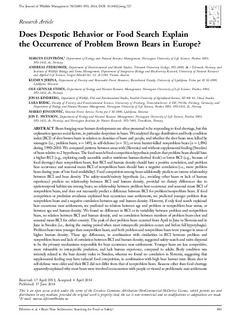Does despotic behavior or food search explain the occurrence of problem brown bears in Europe?
Elfström, Marcus; Zedrosser, Andreas; Jerina, Klemen; Støen, Ole-Gunnar; Kindberg, Jonas; Budic, Lara; Jonozovic, Marko; Swenson, Jon
Journal article, Peer reviewed
Published version
Permanent lenke
http://hdl.handle.net/11250/2437942Utgivelsesdato
2014Metadata
Vis full innførselSamlinger
Sammendrag
Bears foraging near human developments are often presumed to be responding to food shortage, but this explanation ignores social factors, in particular despotism in bears. We analyzed the age distribution and body condition index (BCI) of shot brown bears in relation to densities of bears and people, and whether the shot bears were killed by managers (i.e., problem bears; n = 149), in self-defense (n = 51), or were hunter-killed nonproblem bears (n = 1,896) during 1990–2010. We compared patterns between areas with (Slovenia) and without supplemental feeding (Sweden) of bears relative to 2 hypotheses. The food-search/food-competition hypothesis predicts that problem bears should have a higher BCI (e.g., exploiting easily accessible and/or nutritious human-derived foods) or lower BCI (e.g., because of food shortage) than nonproblem bears, that BCI and human density should have a positive correlation, and problem bear occurrence and seasonal mean BCI of nonproblem bears should have a negative correlation (i.e., more problem bears during years of low food availability). Food competition among bears additionally predicts an inverse relationship between BCI and bear density. The safety-search/naivety hypothesis (i.e., avoiding other bears or lack of human experience) predicts no relationship between BCI and human density, provided no dietary differences due to spatiotemporal habitat use among bears, no relationship between problem bear occurrence and seasonal mean BCI of nonproblem bears, and does not necessarily predict a difference between BCI for problem/nonproblem bears. If food competition or predation avoidance explained bear occurrence near settlements, we predicted younger problem than nonproblem bears and a negative correlation between age and human density. However, if only food search explained bear occurrence near settlements, we predicted no relation between age and problem or nonproblem bear status, or between age and human density. We found no difference in BCI or its variability between problem and nonproblem bears, no relation between BCI and human density, and no correlation between numbers of problem bears shot and seasonal mean BCI for either country. The peak of shot problem bears occurred from April to June in Slovenia and in June in Sweden (i.e., during the mating period when most intraspecific predation occurs and before fall hyperphagia). Problem bears were younger than nonproblem bears, and both problem and nonproblem bears were younger in areas of higher human density. These age differences, in combination with similarities in BCI between problem and nonproblem bears and lack of correlation between BCI and human density, suggested safety-search and naïve dispersal to be the primary mechanisms responsible for bear occurrence near settlements. Younger bears are less competitive, more vulnerable to intraspecific predation, and lack human experience, compared to adults. Body condition was inversely related to the bear density index in Sweden, whereas we found no correlation in Slovenia, suggesting that supplemental feeding may have reduced food competition, in combination with high bear harvest rates. Bears shot in self-defense were older and their BCI did not differ from that of nonproblem bears. Reasons other than food shortage apparently explained why most bears were involved in encounters with people or viewed as problematic near settlements in our study.

